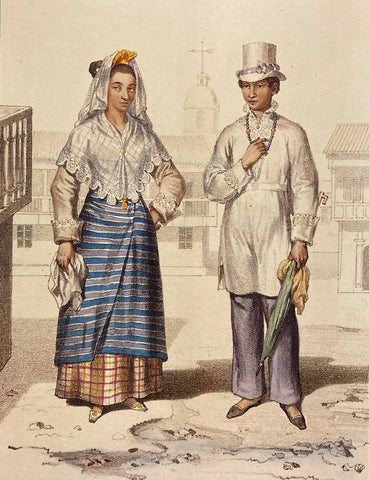
The illustration here is titled Métis Chinois ou Sangley [Chinese Mestizos or Sangley], 1846, from the Jean Mallat book Les Philippines: Histoire, Géographie, Mœurs, Agriculture, Industrie, et Commerce des Colonies Espagnoles dans l’Océanie. Mallat, Bayot and Lemercier are credited as authors of this drawing. A description of Mallat and Les Philippines is in our previous installment Part 10.12.
In this illustration, this woman and man, both of Chinese and native Filipino descent, stand in the middle of town with the church in the background. They are probably of the same social class as the upper class couple we described in yesterday’s post since they are dressed similarly.
The woman wears a long sleeve solid baro (top) with lace French cuffs, a long red and yellow plaid saya (skirt), a blue striped tapis (overskirt), an embroidered translucent pañuelo (shawl) with checker lines possibly made of piña, a gold hair accessory, and an embroidered lace mantilla (veil) on top of her head. She also wears a gold brooch pin enclosure on her pañuelo, a necklace with gold pendant, slippers, and she carries a hankerchief in her right hand.
The man wears a natural color translucent Barong Tagalog, possibly made of piña fabric, that extends down to the top of his knees, with embroidery around the front opening, collar and cuffs, a precious stone as the top button, French cuffs with lace, and a standing Elizabethan collar with lace. He wears a matching top hat, belted solid dark pants, a couple beaded necklaces with gold and slippers on his feet. He clutches an umbrella and hankerchief in his left hand.
They could both be dressed up to attend mass in the church behind them. All of the embroidery depicted on these clothes and accessories was done by hand, and many of these items shown are likely imported. Also the man’s barong is what we would consider a traditional formal barong today, and its length is indicative of the history and foreign influence on this garment.
